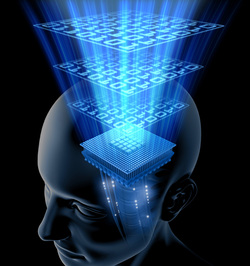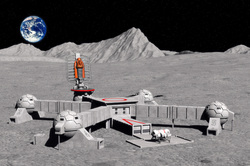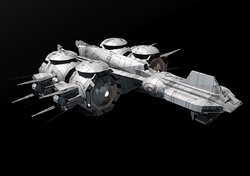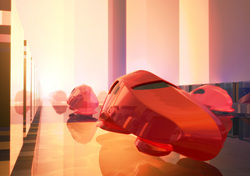These are arranged according to there timeline, generation staring from 1 to 2
1 2 Next>>
Human intelligence is being vastly amplified by AI

Some regions - such as Canada, northern Europe and Russia - have continued to grow and prosper. Large-scale automation in these countries has led to vast swathes of human employees being replaced by virtual or robotic counterparts. AI systems now occupy almost every level of business, government, the military, manufacturing and service sectors.
Rather than being separate entities, these AI programs are often merged with human minds, greatly extending the latter's capability. For instance, knowledge and skills on any subject can now be downloaded and stored directly within the brain. In addition to basic information and data, this includes a range of physical abilities. A person can learn self-defence, for example, become an expert in any sport, or be taught to operate a new vehicle, all within a matter of seconds.
The world is being transformed by this fusion of people and machines. The vastly greater power of AI means that it has become, at the same time, both master and servant to the human race.
The benefits of this human-AI merger require the extensive use of implants, however - something which a significant minority of the population still refuses to accept. Compared to transhumans, these non-upgraded humans are becoming like cavemen - thousands of years behind in intellectual development. Unable to comprehend the latest technology, the world around them appears "fast" and "strange" from their increasingly limited perspective.This is creating a major division in society.
Rather than being separate entities, these AI programs are often merged with human minds, greatly extending the latter's capability. For instance, knowledge and skills on any subject can now be downloaded and stored directly within the brain. In addition to basic information and data, this includes a range of physical abilities. A person can learn self-defence, for example, become an expert in any sport, or be taught to operate a new vehicle, all within a matter of seconds.
The world is being transformed by this fusion of people and machines. The vastly greater power of AI means that it has become, at the same time, both master and servant to the human race.
The benefits of this human-AI merger require the extensive use of implants, however - something which a significant minority of the population still refuses to accept. Compared to transhumans, these non-upgraded humans are becoming like cavemen - thousands of years behind in intellectual development. Unable to comprehend the latest technology, the world around them appears "fast" and "strange" from their increasingly limited perspective.This is creating a major division in society.
Nomadic floating cities are roaming the oceans

At the dawn of the 22nd century, many of the world's cities lie partially submerged due to rising sea levels.Despite some attempts to build flood defences, even famous locations - such as New York, London, Hong Kong, Shanghai and Sydney - have been affected.
With over 10% of the world's population living on coastlines, hundreds of millions have been forced to migrate. However, disruption of inland food and freshwater supplies - caused by drought, disease, war, overpopulation and other factors – means their journeys often end in vain. Some of the worst-hit countries have been plunged into a state of anarchy. Vast uninhabitable wastelands now cover the equatorial regions, with desperate streams of refugees moving from city to city, fighting over what little scraps remain. There is widespread damage to buildings and infrastructure.
In the US, formerly prosperous breadbaskets in the south have been turned into lifeless deserts, while coastal areas are frequently battered by storm surges, category 6 hurricanes and other freak weather events.
Meanwhile, the once mighty Amazon rainforest has been reduced to a few oases of greenery surrounded by parched scrubland and dried river beds.
A growing number of citizens are abandoning their homelands altogether and attempting to reach more northerly or southerly latitudes. However, borders are becoming ever more difficult to cross. Limited food, resources and housing are forcing many governments to drastically rethink their immigration policies.
Rich entrepreneurs are exploiting this, by offering a new means of living which does away with national boundaries altogether. This comes in the form of floating, artificial islands - wholly self-sufficient and capable of cruising around the world indefinitely.
The ships provide the kind of comfort, safety and security that many of their occupants have never experienced before. In addition to a continuous supply of food, freshwater and energy, a number of facilities are available – including state-of-the-art virtual reality suites, android servants/companions, industrial-scale nanotech assemblers, landing pads for anti-grav vehicles, swimming pools and other amenities. Carefully maintained arboretums featuring real trees can also be found on board (flora which are becoming increasingly rare these days).
These giant, amphibious ships are especially popular in southeast Asia, which has been hit hardest by the effects of climate change. Some of the largest craft measure over a kilometre in diameter with tens of thousands of residents. Whole new cultures are forming on these "micronations", based on sustainable ways of living and a mutual respect for humanity and nature.
With over 10% of the world's population living on coastlines, hundreds of millions have been forced to migrate. However, disruption of inland food and freshwater supplies - caused by drought, disease, war, overpopulation and other factors – means their journeys often end in vain. Some of the worst-hit countries have been plunged into a state of anarchy. Vast uninhabitable wastelands now cover the equatorial regions, with desperate streams of refugees moving from city to city, fighting over what little scraps remain. There is widespread damage to buildings and infrastructure.
In the US, formerly prosperous breadbaskets in the south have been turned into lifeless deserts, while coastal areas are frequently battered by storm surges, category 6 hurricanes and other freak weather events.
Meanwhile, the once mighty Amazon rainforest has been reduced to a few oases of greenery surrounded by parched scrubland and dried river beds.
A growing number of citizens are abandoning their homelands altogether and attempting to reach more northerly or southerly latitudes. However, borders are becoming ever more difficult to cross. Limited food, resources and housing are forcing many governments to drastically rethink their immigration policies.
Rich entrepreneurs are exploiting this, by offering a new means of living which does away with national boundaries altogether. This comes in the form of floating, artificial islands - wholly self-sufficient and capable of cruising around the world indefinitely.
The ships provide the kind of comfort, safety and security that many of their occupants have never experienced before. In addition to a continuous supply of food, freshwater and energy, a number of facilities are available – including state-of-the-art virtual reality suites, android servants/companions, industrial-scale nanotech assemblers, landing pads for anti-grav vehicles, swimming pools and other amenities. Carefully maintained arboretums featuring real trees can also be found on board (flora which are becoming increasingly rare these days).
These giant, amphibious ships are especially popular in southeast Asia, which has been hit hardest by the effects of climate change. Some of the largest craft measure over a kilometre in diameter with tens of thousands of residents. Whole new cultures are forming on these "micronations", based on sustainable ways of living and a mutual respect for humanity and nature.
Femtoengineering is practical

Technology on the scale of quadrillionths of a metre (10-15) is becoming possible around this time. This is three orders of magnitude smaller than picotechnology and six orders of magnitude smaller than nanotechnology.
Engineering at this scale involves working directly with the finest known structures of matter - such as quarks and strings - to manipulate the properties of atoms. This development is a further step towards macro-scale teleportation, i.e. transportation of objects visible to the naked eye. Significant breakthroughs in anti-gravity and force field generation will also result from this.
Another area that will see major progress is in materials technology. For example, metals will be produced which are capable of withstanding truly enormous pressures and tensile forces. The applications for this will be endless, but perhaps one of the most exciting areas will be in the exploration of hostile environments - such as probes capable of travelling within the Sun itself, and tunnelling machines that can penetrate the Earth's crust into the layers of magma beneath. Longer term, this development will pave the way for interstellar ships and the massive forces involved in lightspeed travel.
Other more exotic materials are becoming possible - including wholly transparent metals, highly luminous metals, frictionless surfaces, and ultradense but extremely lightweight structures.
As with many areas of science, femtoengineering is being guided by advanced AI, which is now trillions of trillions of times more powerful than unaided human intelligence.
Engineering at this scale involves working directly with the finest known structures of matter - such as quarks and strings - to manipulate the properties of atoms. This development is a further step towards macro-scale teleportation, i.e. transportation of objects visible to the naked eye. Significant breakthroughs in anti-gravity and force field generation will also result from this.
Another area that will see major progress is in materials technology. For example, metals will be produced which are capable of withstanding truly enormous pressures and tensile forces. The applications for this will be endless, but perhaps one of the most exciting areas will be in the exploration of hostile environments - such as probes capable of travelling within the Sun itself, and tunnelling machines that can penetrate the Earth's crust into the layers of magma beneath. Longer term, this development will pave the way for interstellar ships and the massive forces involved in lightspeed travel.
Other more exotic materials are becoming possible - including wholly transparent metals, highly luminous metals, frictionless surfaces, and ultradense but extremely lightweight structures.
As with many areas of science, femtoengineering is being guided by advanced AI, which is now trillions of trillions of times more powerful than unaided human intelligence.
Our solar system is passing through a million degree cloud of gas

The Sun is approaching a boundary between the Local Cloud of interstellar gas and another cloud of extremely turbulent gas - the latter is the remnants of supernova explosions that occurred millions of years ago.
The density of this medium is sufficiently low to pose no threat to Earth or any other planets. The heliosphere is reformed slightly, and the level of cosmic radiation entering the magnetosphere increases, but nothing more.
However, spacecraft and satellites may be damaged by these high energy particles unless they are upgraded.
The density of this medium is sufficiently low to pose no threat to Earth or any other planets. The heliosphere is reformed slightly, and the level of cosmic radiation entering the magnetosphere increases, but nothing more.
However, spacecraft and satellites may be damaged by these high energy particles unless they are upgraded.
Mind uploading enters mainstream society

Adequate hardware to support human-level intelligence was available as far back as the 2020s, thanks to the exponential progress of Moore's Law.* This made it possible to form simulations of neural processes.
However, the underlying software foundation required for mind uploading proved to be a vastly greater challenge. Full transfer of human consciousness into artificial substrates posed enormous technical difficulties, in addition to raising ethical and philosophical issues.
The sheer complexity of the brain, and its inherent fragility - along with the many legislative barriers that stood in the way - meant that it was nearly a century before such technology reached the mainstream.
Some breakthroughs occurred in the latter decades of the 21st century, with partial transfer of memories and thought patterns, allowing some limited experience of the mind uploading process. However, it was only through the emergence of picotechnology and strong AI that sufficiently detailed scanning methods became available. This new generation of machines, being orders of magnitude faster and more robust, finally bridged the gap between organic human brains and their synthetic equivalents.
Initially tested on monkeys, the procedure was eventually offered to certain marginalised people including death row inmates and terminally ill patients. Once it could be demonstrated as being safe and reversible, the project garnered a steady stream of free and healthy volunteers, tempted by this new form of computerised immortality.
Years of red tape and legislation followed, including some of the strictest regulations ever enacted into law. Religious and conservative groups voiced their objections to what they saw as a fundamental violation of God's will. At times, this threatened to postpone the technology indefinitely. Eventually though, like so many other breakthroughs in science, the zeitgeist moved on. The level of demand for mind uploading proved to be enormous, and the treatment was made commercially available in the 2120s.
Today, citizens have access to special clinics in which their biological brains can be literally discarded in favour of artificial ones. Rather than simply "duplicating" a mind, the machine physically shifts the consciousness, like a sponge soaking up water. The brain is gradually replaced - piece by piece - so the original personality remains intact during the transition. This vital aspect of the procedure assuages the fear which many have of losing their identity.
For the wealthiest individuals, entire new bodies can be grown, into which the synthetic brains can be transplanted. These bodies may themselves be artificial, with options for partially cyborg or fully robotic replacements. Externally, they are often indistinguishable from real human bodies, but include many hi-tech add-ons and internal features boosting physical and mental abilities.
Not everyone is opting for these types of treatments, however. A significant percentage view them with extreme suspicion, as though somehow immoral and dehumanising. With each passing year, society is becoming increasingly fractured, with an ever-widening divide between those who seek to enhance themselves, and those who prefer to eschew such technology.
However, the underlying software foundation required for mind uploading proved to be a vastly greater challenge. Full transfer of human consciousness into artificial substrates posed enormous technical difficulties, in addition to raising ethical and philosophical issues.
The sheer complexity of the brain, and its inherent fragility - along with the many legislative barriers that stood in the way - meant that it was nearly a century before such technology reached the mainstream.
Some breakthroughs occurred in the latter decades of the 21st century, with partial transfer of memories and thought patterns, allowing some limited experience of the mind uploading process. However, it was only through the emergence of picotechnology and strong AI that sufficiently detailed scanning methods became available. This new generation of machines, being orders of magnitude faster and more robust, finally bridged the gap between organic human brains and their synthetic equivalents.
Initially tested on monkeys, the procedure was eventually offered to certain marginalised people including death row inmates and terminally ill patients. Once it could be demonstrated as being safe and reversible, the project garnered a steady stream of free and healthy volunteers, tempted by this new form of computerised immortality.
Years of red tape and legislation followed, including some of the strictest regulations ever enacted into law. Religious and conservative groups voiced their objections to what they saw as a fundamental violation of God's will. At times, this threatened to postpone the technology indefinitely. Eventually though, like so many other breakthroughs in science, the zeitgeist moved on. The level of demand for mind uploading proved to be enormous, and the treatment was made commercially available in the 2120s.
Today, citizens have access to special clinics in which their biological brains can be literally discarded in favour of artificial ones. Rather than simply "duplicating" a mind, the machine physically shifts the consciousness, like a sponge soaking up water. The brain is gradually replaced - piece by piece - so the original personality remains intact during the transition. This vital aspect of the procedure assuages the fear which many have of losing their identity.
For the wealthiest individuals, entire new bodies can be grown, into which the synthetic brains can be transplanted. These bodies may themselves be artificial, with options for partially cyborg or fully robotic replacements. Externally, they are often indistinguishable from real human bodies, but include many hi-tech add-ons and internal features boosting physical and mental abilities.
Not everyone is opting for these types of treatments, however. A significant percentage view them with extreme suspicion, as though somehow immoral and dehumanising. With each passing year, society is becoming increasingly fractured, with an ever-widening divide between those who seek to enhance themselves, and those who prefer to eschew such technology.
The International Space Elevator is operational

Rising from the Pacific Rim, this mega-structure is thousands of miles high. Decades in the making, it has been built entirely from carbon nanotubes. These are hundreds of times stronger than ordinary steel and capable of withstanding the enormous tensile forces involved. The elevator is controlled largely by AI, which monitors any stresses or unusual conditions.
One major obstacle to the project's completion - aside from the initial outlay - was the need for international agreements on safety, security and insurance in the event of an accident. Although the technology was available as far back as 2040, these issues (and others) delayed construction by many years.
A major space boom is now finally underway, as passengers can be delivered to orbit at vastly reduced costs, compared with traditional rocket launches.
One major obstacle to the project's completion - aside from the initial outlay - was the need for international agreements on safety, security and insurance in the event of an accident. Although the technology was available as far back as 2040, these issues (and others) delayed construction by many years.
A major space boom is now finally underway, as passengers can be delivered to orbit at vastly reduced costs, compared with traditional rocket launches.
Large-scale civilian settlement of the Moon is underway

As a result of the International Space Elevator, huge numbers of Earth's citizens now have rapid, affordable and safe access to space. Dozens of permanent Moon colonies are now being established, funded by various cooperative groups. Nanotechnology self-assemblers enable these habitats to be constructed in hours or days.Most are concentrated in the southern polar region, which has greater access to water.
Advances in genetic engineering mean that humans can be fully adapted to the gravity of the Moon. In any case, scientists are developing a form of artificial gravity that will soon become available.
In addition to basic exploration and surveying, the main occupations for colonists at the moment are scientific and technological research, mining, agriculture, energy production, communications and transport/infrastructure management. Many tasks are handled by robots, giving more leisure time for the human residents.
Tourism is now a booming industry, with many thousands of people arriving on the Moon's surface each year for guided tours - even though VR simulations can recreate the Moon's environment. The most popular destinations are Mons Huygens (the highest mountain), Tycho (a prominent crater visible from Earth) and the Apollo landing sites.
A very large telescope is also operational, for long-distance astronomical observations. The lack of atmosphere and other conditions gives it a tremendous advantage over Earth-based telescopes.
Advances in genetic engineering mean that humans can be fully adapted to the gravity of the Moon. In any case, scientists are developing a form of artificial gravity that will soon become available.
In addition to basic exploration and surveying, the main occupations for colonists at the moment are scientific and technological research, mining, agriculture, energy production, communications and transport/infrastructure management. Many tasks are handled by robots, giving more leisure time for the human residents.
Tourism is now a booming industry, with many thousands of people arriving on the Moon's surface each year for guided tours - even though VR simulations can recreate the Moon's environment. The most popular destinations are Mons Huygens (the highest mountain), Tycho (a prominent crater visible from Earth) and the Apollo landing sites.
A very large telescope is also operational, for long-distance astronomical observations. The lack of atmosphere and other conditions gives it a tremendous advantage over Earth-based telescopes.
Interstellar travel is becoming possible

Around this time, various private commercial spacecraft are sent to Alpha Centauri, Barnard's Star, Wolf 359 and other neighbouring star systems. The fastest of these are capable of achieving 0.08-0.1c (8-10% lightspeed), requiring around 40 years to reach their destination.* A variety of propulsion systems are being utilised - from nuclear pulse propulsion, to solar sail technology, to other more experimental methods.
Most of these vessels are crewless, with only a handful of humans daring enough to attempt such a voyage. However, each craft is equipped with powerful AI, automated systems and robots which do a better job than any human could, in any case.
Protection from incoming meteors is provided by cone-shaped force fields, projected from the front of each craft. This streamlined shape allows such debris to simply drift by without causing any damage.
After several decades of interstellar travel, the majority of probes successfully rendezvous with their destinations. Each returns a treasure trove of data and visual information. Among the many discoveries is a planet similar in size to Earth, with over 90% of its surface covered in liquid water, though no life forms are detected. Another, much larger and rockier world is discovered in the same system, with a highly active geology and volcanism. A host of interesting and unique moons, asteroids, ring systems and other astronomical features are catalogued.
The success of these missions acts as a catalyst, further accelerating the current boom in space travel.
Most of these vessels are crewless, with only a handful of humans daring enough to attempt such a voyage. However, each craft is equipped with powerful AI, automated systems and robots which do a better job than any human could, in any case.
Protection from incoming meteors is provided by cone-shaped force fields, projected from the front of each craft. This streamlined shape allows such debris to simply drift by without causing any damage.
After several decades of interstellar travel, the majority of probes successfully rendezvous with their destinations. Each returns a treasure trove of data and visual information. Among the many discoveries is a planet similar in size to Earth, with over 90% of its surface covered in liquid water, though no life forms are detected. Another, much larger and rockier world is discovered in the same system, with a highly active geology and volcanism. A host of interesting and unique moons, asteroids, ring systems and other astronomical features are catalogued.
The success of these missions acts as a catalyst, further accelerating the current boom in space travel.
Androids physically indistinguishable from real humans

Androids have been appearing amongst the general populace for many decades already. However, it is by the middle of this century that they achieve a truly lifelike appearance, movement and interaction - making them indistinguishable from real people. Many are now employed in service-based roles.
The typical android of today would appear somewhat calm and subdued, however. They would rarely (if ever) express any strong emotions. Their cognitive abilities would be geared towards hard facts and objective data, rather than subjective views or emotional reasoning.
For this reason, most are regarded as servants at this point in history. However, advances will be made in the coming decades enabling them to replicate even the subtlest of human traits. With androids playing an increasing role in society, a civil rights movement will develop, similar to that which dominated America 200 years earlier.
The typical android of today would appear somewhat calm and subdued, however. They would rarely (if ever) express any strong emotions. Their cognitive abilities would be geared towards hard facts and objective data, rather than subjective views or emotional reasoning.
For this reason, most are regarded as servants at this point in history. However, advances will be made in the coming decades enabling them to replicate even the subtlest of human traits. With androids playing an increasing role in society, a civil rights movement will develop, similar to that which dominated America 200 years earlier.
Hi-tech, automated cities

An observer from the previous century - walking through a newly developed city of today - would be struck by the sense of cleanliness and order. The air would smell fresh and pure, as if they were in 20th century countryside. Roads and pavements would be immaculate: made of special materials that cleaned themselves, absorbed garbage and could self-repair in the event of damage. Building surfaces, windows and roofs would be completely resistant to dirt, bacteria, weather, graffiti and vandalism. These same coatings would be applied to public transport, cars and other vehicles. Everything would appear brand new, shiny and in perfect condition at all times. Greenery would feature heavily in this city, along with spectacular fountains, sculptures and other beautification.
Lamp posts, telegraph poles, signs, bollards and other "clutter" that once festooned the streets have disappeared. Lighting is now achieved more discretely, using a combination of self-illuminating walls and surfaces, antigravity and other features designed to hide these eyesores, maximising pedestrian space and aesthetics. Electricity is passed wirelessly from building to building. Room temperature superconductors - implanted in the ground - allow the rapid movement of vehicles without the need for tracks, wheels, overhead cables or other bulky components. Cars and trains simply drift along silently, riding on electromagnetic currents.
Sign posts are obsolete - all information is beamed electronically into a person's visual cortex. They merely have to "think" of a particular building, street or route to be given information about it.
This observer would also notice their increased personal space, and the relative quiet of areas that, in earlier times, would have bustled with cars, people and movement. In some places, robots tending to manual duties might outnumber humans. This is partly as a result of the drastic reduction in the world's population. However, it is also because citizens of today spend the majority of their time in virtual environments. These wholly convincing, simulated realities offer practically everything a person needs in terms of knowledge, communication and interaction – often at speeds vastly greater than real time. Limited only by a person's imagination, they can provide richer and more stimulating experiences than just about anything in the physical world.
On those rare occasions when a person ventures outside, they are likely to spend little time on foot. Almost all services and material needs can be obtained within the home, or practically on their doorstep - whether it be food, medical assistance, or even replacement body parts and physical upgrades. A "shop" in the developed world is likely to be run entirely by AI. It will know exactly what you need before you even set foot in it, and will have everything ready upon your arrival (if you even arrive at all, since robots can deliver most goods and services). The same goes for hospitals and other amenities.
Social gatherings in the real world tend to be infrequent - usually reserved for "special" occasions such as funerals, for novelty value, or the small number of situations where VR is impractical.
Crime is almost non-existent in these hi-tech cities. Surveillance is everywhere: recording every footstep of your journey in perfect detail and identifying who you are, from the moment you enter a public area. Even your internal biological state can be monitored - such as neural activity and pulse - giving clues as to your immediate intentions. Police can be summoned instantly, with robotic officers appearing to 'grow' out of the ground through the use of blended claytronics and nanobots, embedded into the buildings and roads. This is so much faster and more efficient that in most cities, having law enforcement drive or fly to a crime area (in physical vehicles) has become obsolete.
Lamp posts, telegraph poles, signs, bollards and other "clutter" that once festooned the streets have disappeared. Lighting is now achieved more discretely, using a combination of self-illuminating walls and surfaces, antigravity and other features designed to hide these eyesores, maximising pedestrian space and aesthetics. Electricity is passed wirelessly from building to building. Room temperature superconductors - implanted in the ground - allow the rapid movement of vehicles without the need for tracks, wheels, overhead cables or other bulky components. Cars and trains simply drift along silently, riding on electromagnetic currents.
Sign posts are obsolete - all information is beamed electronically into a person's visual cortex. They merely have to "think" of a particular building, street or route to be given information about it.
This observer would also notice their increased personal space, and the relative quiet of areas that, in earlier times, would have bustled with cars, people and movement. In some places, robots tending to manual duties might outnumber humans. This is partly as a result of the drastic reduction in the world's population. However, it is also because citizens of today spend the majority of their time in virtual environments. These wholly convincing, simulated realities offer practically everything a person needs in terms of knowledge, communication and interaction – often at speeds vastly greater than real time. Limited only by a person's imagination, they can provide richer and more stimulating experiences than just about anything in the physical world.
On those rare occasions when a person ventures outside, they are likely to spend little time on foot. Almost all services and material needs can be obtained within the home, or practically on their doorstep - whether it be food, medical assistance, or even replacement body parts and physical upgrades. A "shop" in the developed world is likely to be run entirely by AI. It will know exactly what you need before you even set foot in it, and will have everything ready upon your arrival (if you even arrive at all, since robots can deliver most goods and services). The same goes for hospitals and other amenities.
Social gatherings in the real world tend to be infrequent - usually reserved for "special" occasions such as funerals, for novelty value, or the small number of situations where VR is impractical.
Crime is almost non-existent in these hi-tech cities. Surveillance is everywhere: recording every footstep of your journey in perfect detail and identifying who you are, from the moment you enter a public area. Even your internal biological state can be monitored - such as neural activity and pulse - giving clues as to your immediate intentions. Police can be summoned instantly, with robotic officers appearing to 'grow' out of the ground through the use of blended claytronics and nanobots, embedded into the buildings and roads. This is so much faster and more efficient that in most cities, having law enforcement drive or fly to a crime area (in physical vehicles) has become obsolete.
